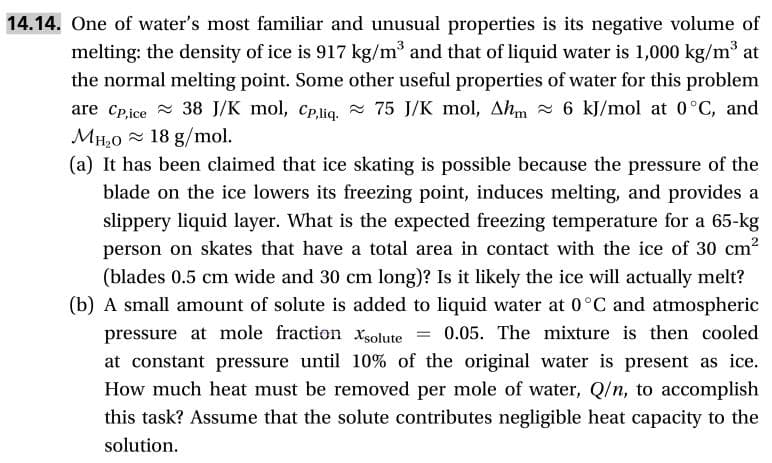14.14. One of water's most familiar and unusual properties is its negative volume of melting: the density of ice is 917 kg/m3 and that of liquid water is 1,000 kg/m3 at the normal melting point. Some other useful properties of water for this problem are Cpice 38 J/K mol, cpliq 75 J/K mol, Ahm6 kJ/mol at 0°C, and MH20 18 g/mol (a) It has been claimed that ice skating is possible because the pressure of the blade on the ice lowers its freezing point, induces melting, and provides a slippery liquid layer. What is the expected freezing temperature for a 65-kg person on skates that have a total area in contact with the ice of 30 cm2 (blades 0.5 cm wide and 30 cm long)? Is it likely the ice will actually melt? (b) A small amount of solute is added to liquid water at 0°C and atmospheric pressure at mole fraction xolute at constant pressure until 10% of the original water is present as ice How much heat must be removed per mole of water, Q/n, to accomplish 0.05. The mixture is then cooled this task? Assume that the solute contributes negligible heat capacity to the solution
14.14. One of water's most familiar and unusual properties is its negative volume of melting: the density of ice is 917 kg/m3 and that of liquid water is 1,000 kg/m3 at the normal melting point. Some other useful properties of water for this problem are Cpice 38 J/K mol, cpliq 75 J/K mol, Ahm6 kJ/mol at 0°C, and MH20 18 g/mol (a) It has been claimed that ice skating is possible because the pressure of the blade on the ice lowers its freezing point, induces melting, and provides a slippery liquid layer. What is the expected freezing temperature for a 65-kg person on skates that have a total area in contact with the ice of 30 cm2 (blades 0.5 cm wide and 30 cm long)? Is it likely the ice will actually melt? (b) A small amount of solute is added to liquid water at 0°C and atmospheric pressure at mole fraction xolute at constant pressure until 10% of the original water is present as ice How much heat must be removed per mole of water, Q/n, to accomplish 0.05. The mixture is then cooled this task? Assume that the solute contributes negligible heat capacity to the solution
Introduction to Chemical Engineering Thermodynamics
8th Edition
ISBN:9781259696527
Author:J.M. Smith Termodinamica en ingenieria quimica, Hendrick C Van Ness, Michael Abbott, Mark Swihart
Publisher:J.M. Smith Termodinamica en ingenieria quimica, Hendrick C Van Ness, Michael Abbott, Mark Swihart
Chapter1: Introduction
Section: Chapter Questions
Problem 1.1P
Related questions
Question

Transcribed Image Text:14.14. One of water's most familiar and unusual properties is its negative volume of
melting: the density of ice is 917 kg/m3 and that of liquid water is 1,000 kg/m3 at
the normal melting point. Some other useful properties of water for this problem
are Cpice 38 J/K mol, cpliq 75 J/K mol, Ahm6 kJ/mol at 0°C, and
MH20 18 g/mol
(a) It has been claimed that ice skating is possible because the pressure of the
blade on the ice lowers its freezing point, induces melting, and provides a
slippery liquid layer. What is the expected freezing temperature for a 65-kg
person on skates that have a total area in contact with the ice of 30 cm2
(blades 0.5 cm wide and 30 cm long)? Is it likely the ice will actually melt?
(b) A small amount of solute is added to liquid water at 0°C and atmospheric
pressure at mole fraction xolute
at constant pressure until 10% of the original water is present as ice
How much heat must be removed per mole of water, Q/n, to accomplish
0.05. The mixture is then cooled
this task? Assume that the solute contributes negligible heat capacity to the
solution
Expert Solution
This question has been solved!
Explore an expertly crafted, step-by-step solution for a thorough understanding of key concepts.
This is a popular solution!
Trending now
This is a popular solution!
Step by step
Solved in 5 steps with 3 images

Recommended textbooks for you

Introduction to Chemical Engineering Thermodynami…
Chemical Engineering
ISBN:
9781259696527
Author:
J.M. Smith Termodinamica en ingenieria quimica, Hendrick C Van Ness, Michael Abbott, Mark Swihart
Publisher:
McGraw-Hill Education

Elementary Principles of Chemical Processes, Bind…
Chemical Engineering
ISBN:
9781118431221
Author:
Richard M. Felder, Ronald W. Rousseau, Lisa G. Bullard
Publisher:
WILEY

Elements of Chemical Reaction Engineering (5th Ed…
Chemical Engineering
ISBN:
9780133887518
Author:
H. Scott Fogler
Publisher:
Prentice Hall

Introduction to Chemical Engineering Thermodynami…
Chemical Engineering
ISBN:
9781259696527
Author:
J.M. Smith Termodinamica en ingenieria quimica, Hendrick C Van Ness, Michael Abbott, Mark Swihart
Publisher:
McGraw-Hill Education

Elementary Principles of Chemical Processes, Bind…
Chemical Engineering
ISBN:
9781118431221
Author:
Richard M. Felder, Ronald W. Rousseau, Lisa G. Bullard
Publisher:
WILEY

Elements of Chemical Reaction Engineering (5th Ed…
Chemical Engineering
ISBN:
9780133887518
Author:
H. Scott Fogler
Publisher:
Prentice Hall


Industrial Plastics: Theory and Applications
Chemical Engineering
ISBN:
9781285061238
Author:
Lokensgard, Erik
Publisher:
Delmar Cengage Learning

Unit Operations of Chemical Engineering
Chemical Engineering
ISBN:
9780072848236
Author:
Warren McCabe, Julian C. Smith, Peter Harriott
Publisher:
McGraw-Hill Companies, The